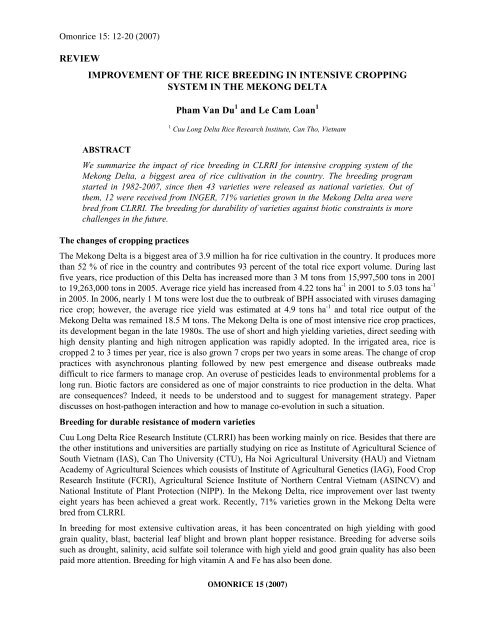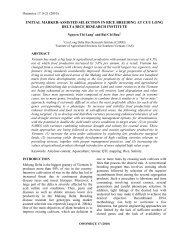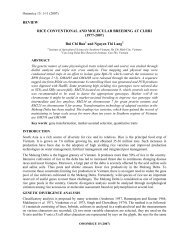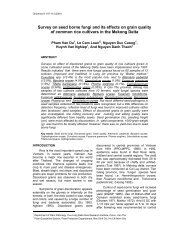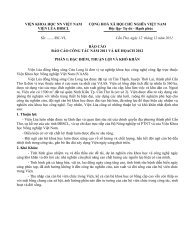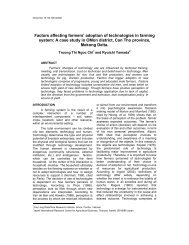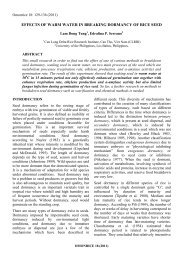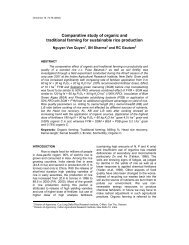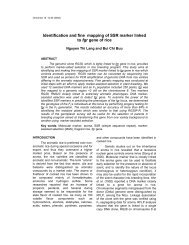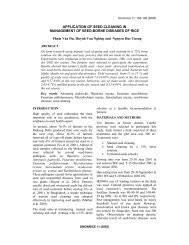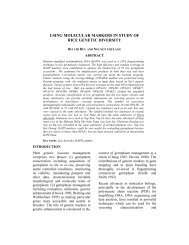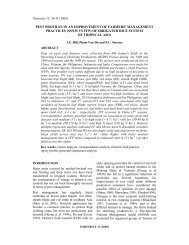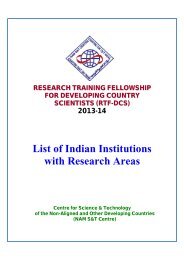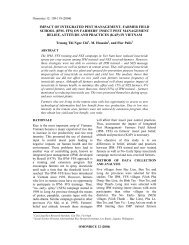REVIEW IMPROVEMENT OF THE RICE BREEDING IN INTENSIVE ...
REVIEW IMPROVEMENT OF THE RICE BREEDING IN INTENSIVE ...
REVIEW IMPROVEMENT OF THE RICE BREEDING IN INTENSIVE ...
Create successful ePaper yourself
Turn your PDF publications into a flip-book with our unique Google optimized e-Paper software.
Omonrice 15: 12-20 (2007)<br />
<strong>REVIEW</strong><br />
<strong>IMPROVEMENT</strong> <strong>OF</strong> <strong>THE</strong> <strong>RICE</strong> <strong>BREED<strong>IN</strong>G</strong> <strong>IN</strong> <strong>IN</strong>TENSIVE CROPP<strong>IN</strong>G<br />
SYSTEM <strong>IN</strong> <strong>THE</strong> MEKONG DELTA<br />
Pham Van Du 1 and Le Cam Loan 1<br />
1 Cuu Long Delta Rice Research Institute, Can Tho, Vietnam<br />
ABSTRACT<br />
We summarize the impact of rice breeding in CLRRI for intensive cropping system of the<br />
Mekong Delta, a biggest area of rice cultivation in the country. The breeding program<br />
started in 1982-2007, since then 43 varieties were released as national varieties. Out of<br />
them, 12 were received from <strong>IN</strong>GER, 71% varieties grown in the Mekong Delta area were<br />
bred from CLRRI. The breeding for durability of varieties against biotic constraints is more<br />
challenges in the future.<br />
The changes of cropping practices<br />
The Mekong Delta is a biggest area of 3.9 million ha for rice cultivation in the country. It produces more<br />
than 52 % of rice in the country and contributes 93 percent of the total rice export volume. During last<br />
five years, rice production of this Delta has increased more than 3 M tons from 15,997,500 tons in 2001<br />
to 19,263,000 tons in 2005. Average rice yield has increased from 4.22 tons ha -1 in 2001 to 5.03 tons ha -1<br />
in 2005. In 2006, nearly 1 M tons were lost due the to outbreak of BPH associated with viruses damaging<br />
rice crop; however, the average rice yield was estimated at 4.9 tons ha -1 and total rice output of the<br />
Mekong Delta was remained 18.5 M tons. The Mekong Delta is one of most intensive rice crop practices,<br />
its development began in the late 1980s. The use of short and high yielding varieties, direct seeding with<br />
high density planting and high nitrogen application was rapidly adopted. In the irrigated area, rice is<br />
cropped 2 to 3 times per year, rice is also grown 7 crops per two years in some areas. The change of crop<br />
practices with asynchronous planting followed by new pest emergence and disease outbreaks made<br />
difficult to rice farmers to manage crop. An overuse of pesticides leads to environmental problems for a<br />
long run. Biotic factors are considered as one of major constraints to rice production in the delta. What<br />
are consequences? Indeed, it needs to be understood and to suggest for management strategy. Paper<br />
discusses on host-pathogen interaction and how to manage co-evolution in such a situation.<br />
Breeding for durable resistance of modern varieties<br />
Cuu Long Delta Rice Research Institute (CLRRI) has been working mainly on rice. Besides that there are<br />
the other institutions and universities are partially studying on rice as Institute of Agricultural Science of<br />
South Vietnam (IAS), Can Tho University (CTU), Ha Noi Agricultural University (HAU) and Vietnam<br />
Academy of Agricultural Sciences which cousists of Institute of Agricultural Genetics (IAG), Food Crop<br />
Research Institute (FCRI), Agricultural Science Institute of Northern Central Vietnam (AS<strong>IN</strong>CV) and<br />
National Institute of Plant Protection (NIPP). In the Mekong Delta, rice improvement over last twenty<br />
eight years has been achieved a great work. Recently, 71% varieties grown in the Mekong Delta were<br />
bred from CLRRI.<br />
In breeding for most extensive cultivation areas, it has been concentrated on high yielding with good<br />
grain quality, blast, bacterial leaf blight and brown plant hopper resistance. Breeding for adverse soils<br />
such as drought, salinity, acid sulfate soil tolerance with high yield and good grain quality has also been<br />
paid more attention. Breeding for high vitamin A and Fe has also been done.<br />
OMON<strong>RICE</strong> 15 (2007)
Improvement of the rice breeding in intensive cropping system in the Mekong delta<br />
13<br />
In 1986-2006, the released varieties as national varieties were high yield, good grain quality and resistant<br />
to brown plant hopper (BPH) and Blast. However, these varieties recently become susceptible to major<br />
insects and diseases such as brown plant hopper, blast, bacterial leaf blight, grassy and ragged stunt<br />
viruses. Interestingly, still some varieties have shown field blast resistance and drought/salinity/acid<br />
sulfate tolerance such as OM 576, IR 50404-57-2-2-3, AS 996, VND 95-20, OM 4498 and OM 5930<br />
since released. Most of promising and leading varieties have the common ancestors as IR 64 and IR 48;<br />
therefore the new genetic resources are being looked for in breeding programs to prevent the narrow<br />
genetic base and then created genetic vulnerability because of the similarity in their genotype.<br />
The varieties with high yielding and short growth duration
14<br />
Pham van Du and Le Cam Loan<br />
Released varieties in the country<br />
In 2005, there were 66 varieties grown in the Mekong Delta Area. Of them, 43 were bred varieties,<br />
9 were exotic varieties and 14 were local rice varieties. The leading varieties were OM 1490, OM 2517,<br />
OMCS 2000, Jasmine 85, OM 2718, IR 50404, VND 95-20, OM 2717, OM 576 and OM 3536 occupied<br />
76% Mekong area.<br />
CLRRI used some entries received from <strong>IN</strong>GER in the hybridization work, the followings resulted in<br />
released varieties as IR 5, IR 8, IR 36, IR 42, IR 48, IR 50, IR 64, IR 66, IR 68, IR 5853-229, IR 19735-<br />
5-2-3-2, IR 32843, IR 2307-247-2-2-3, A69-1, IR 44592, IR 50401, IR 32893, MRC 19399, IR 59606,<br />
IR 19746-11-33, IR 529-640-3-2, IR 8423-132-622, IET 2938, IR 2588, Pelita 1 and IR 2513-26-5-3-2.<br />
In CLRRI, breeding programs has been started since 1982. There were 43 varieties released from 1986-<br />
2006 as national varieties. Out of them, 12 were received from <strong>IN</strong>GER as IR 42, IR 48, IR 64, IR 66,<br />
IR 19660, IR 62032, MRC 19399, IR 44595-70-2-2-3, IR 35546-17, IR 29723, IR 49517-23, and IR<br />
59606 (Table 1). Only IR 42 and IR 64 are still cultivated but the area has reduced over time because<br />
they are susceptible to some important diseases and insects. The others are MTL 233 (IR 65610-24-3-6-<br />
3-2-3) and MTL 250 (IR 68077-64-2-2-2-2) introduced from Can Tho University and IR 50404-57-2-2-3<br />
from Institute of Agricultural Science of South Vietnam.<br />
Table 1: List of national varieties released in Southern Vietnam<br />
No. National Pedigree/Origin<br />
National<br />
Pedigree/Origin<br />
varieties<br />
varieties<br />
1 NN 4B IR 42 27 OM 1723 OM 554 / IR 50401<br />
2 NN 5B IR 48 28 OM 1633 IR 2307-247-2-2-3 / IR32893<br />
3 OM 89 IR 64 29 OM 2031 Lua Thai Lan / Bong Huong<br />
4 OM 80 IR 36 / IR 5853-229 30 CM 16-27** Norin 12 / OM 987<br />
5 OM 86-9 IR 21015-80-3-3-2 31 OMCS 2000 OM 1723 / MRC 19399<br />
6 IR 66 IR 66 32 AS 996 IR 64 / O. rufipogon<br />
7 OM 576-18 Hungary / IR 48 33 OM 1348-9 IR 42 / OM 736<br />
8 OM 597 IR 48 / IR 19735-5-2-3-2 34 OM 2395 IR 63356-6B / TN1<br />
9 IR 19660 IR 19660 35 OM 3536 TD 8 / OM 1738<br />
10 OM 90-2 IR 44595-70-2-2-3 36 OM 1352 IR 42 / OM 80<br />
11 OM 90-9 IR 35546-17 37 DS 20 Taiwan<br />
12 IR 29723 IR 29723 38 OM 2717 OM 1738 / Tai Nguyen DB 100<br />
13 OM 269-65 IR 32843 / NN 6A 39 OM 2718 OM 1738 / Mong Chim Roi DB<br />
14 IR 49517-23 IR 49517-23 40 OM 2514 OM 1314 / Nep mat troi<br />
15 OM 997-6 Colombia / IR 64 41 OM 2517 OM 1325 / OMCS 94<br />
16 OM 723-7 IR 2307-247-2-2-3 / A69-1 42 OM 4495 IR 64 / OM 1706//IR 64<br />
17 KDM 105 Thailand 43 OM 4498 IR 64 / OMCS 2000//IR 64<br />
18 OMCS 94 IR 59606 44 IR 50404*** IR 50404-57-2-2-3<br />
19 OM 1589 IR 36 / IR 50 45 KSB 54 IR 18189-2-3-2 / IR 36<br />
20 OMCS 95-5 OMCS 6 / IR 68 46 KSB 218-11-1 IR 32439-112-3 / IR 8423<br />
21 IR 62032 IR 62032 47 KSB 55 IR 64 / IR 8423<br />
22 OM Fi1 MRC 19399 48 VND 95-19 IR 64 *<br />
23 TN 108 Tai Nguyen* 49 VND 95-20 IR 64*<br />
24 OM 1706 OM 90 / OM 33 50 MTL 233 IR 65610-24-3-6-3-2-3<br />
25 Tai Nguyen Tai Nguyen* 51 MTL 250 IR 68077-64-2-2-2-2<br />
26 OM 1490 OM 606 / IR 44592<br />
* mutation ** anther culture ***Varieties (bold letter) from IAS and CTU<br />
OMON<strong>RICE</strong> 15 (2007)
Improvement of the rice breeding in intensive cropping system in the Mekong delta<br />
15<br />
Resistance of released varieties to blast (Pyricularia grisea)<br />
Rice blast caused by Pyricularia grisea (Rossman et al. 1990), is one of major rice diseases in the<br />
Mekong Delta of Vietnam. Infected area increased from 1999 to 2003. During dry season 02-03,<br />
189,000 ha were infected in a total of 1.6 M ha of direct seeded rice crop. Most of new releasing varieties<br />
were found to be susceptible to the disease.<br />
Results from blast nurseries conducted since 1980-2004 indicated that most of previously released<br />
varieties were susceptible to blast, some of them are still considered as durable resistance and cultivated<br />
in large scale for more than 15 years. Nowadays, resistant varieties are overcome by blast pathogen with<br />
average of 1-2 years after released (Du and Loan 2004) (Table 2).<br />
Table 2: Reaction of promising lines and varieties to blast (Pyricularia grisea Sacc.) scored at O Mon,<br />
Can Tho from 1980-2004<br />
No. Varieties Year<br />
released/<br />
scale<br />
Years *<br />
90 91 92 93 94 95 96 97 98 99 00 02 04<br />
1 IR 42 1980 5 + + + + + + + + + + + + +<br />
2 IR 48 1980 1 - - - - - - - - + + + + +<br />
3 IR 64 1984 1 - - - - - - - - - - + + +<br />
4 OM 576 1986 4 - + + + + + + + + + + + +<br />
5 IR 50404 1988 2 - - - - - - - + + + + + +<br />
7 OM 1490 1992 1 (1) - - - - - - + + + +<br />
8 OM 2037 1995 1 (1) - - - - + + +<br />
10 OM 2031 1997 1 (1) - - - + +<br />
15 VÑ 20 1997 7 + + + + + +<br />
15 KHAO 39 1998 9 + + + + +<br />
11 OM 3536 2000 5 (5) + +<br />
17 OMCS 2000 2000 7 + + +<br />
18 OM 4495 2000 7 + + +<br />
20 OM 2717 2000 9 + + +<br />
19 OM 3242 2001 9 + + +<br />
12 OM 2517 2002 3 (3) +<br />
13 OM 2490 2002 3 (3) +<br />
14 OM 2519 2002 3 (3) +<br />
21 OM 2718 2002 7 (7) +<br />
22 OM 2492 2002 9 (9) +<br />
* (-) resistant ; (+) susceptible.<br />
The number in parenthesis indicates the reaction of variety to blast in the years after released<br />
Identification of blast races using 129 blast isolates collected in many places of Vietnam (Noda et al.<br />
1999) indicated 12 pathogenic groups based on their virulence to 12 Japanese differential rice varieties. It<br />
was also shown that none of isolates were virulent to differentials which carry genes Pik-s, Pish, Pik, Piz,<br />
Pita-2, Piz-t and Pik-p. Study intended recently to determine which resistance genes is more durable<br />
against blast over time and space using the same Kiyosawa’s varieties and 31 monogenic lines under<br />
natural condition of blast nursery (Ou 1965). Results indicated that in one location tested, reaction can be<br />
changed over time (8 seasons) from resistant to susceptible and vice versa. Some resistance genes could<br />
express resistance to blast for almost of times such as Pik-m (Kanto-51), Piz+ Pish (Fukunishiki),<br />
Pita-2+ Pish (PiNo.4), Piz-t (Toride 1), Pik-p (K60). When observation was conducted in 10 locations<br />
then reaction was also different, effective resistance genes found in almost 10 locations tested such as<br />
Piz, Pish (Fukunishiki), Piz-t (Toride 1), Pik-p (K60) and Pik-m (Tsuyuake, 10 % susceptible)<br />
Some interchanges of resistance and susceptibility such as Pik-s+Pish (Shin 2, 40 % susceptible),<br />
Pia+Pi19(t) (Aichi Asahi, 70 % of susceptible), Pii+Pik-s (Ishikari Shiroke, 30 % of susceptible),<br />
OMON<strong>RICE</strong> 15 (2007)
16<br />
Pham van Du and Le Cam Loan<br />
Pik (Kusabue, 20 % suceptible), Pi-ta (Yashimorochi, 40 % susceptible), Pita-2+Pish (PiNo.4, 20 %<br />
susceptible), Pib+Pi-sh (BL1, 20 % susceptible), Pit (K59, 50 % susceptible). In this study some blast<br />
resistance genes have been identified to be more durability to blast pathogens such as Pik-m (Tsuyuake),<br />
Piz+Pish (Fukunishiki), Piz-t (Toride 1) and Pik-p (K60). However, some varieties of Kiyosawa’s<br />
differential carry two resistance genes Recently, reaction of 31 monogenic lines by natural infection of<br />
blast (multilocation test) and inoculation test with 540 isolates have been conducted (data not shown<br />
here). Differential system will be developed in Vietnam (Pham Van Du et al. 2007). In near future gene<br />
pyramiding is going to be set up for blast resistance breeding program at CLRRI.<br />
Evaluation on resistance genes against rice bacterial leaf blight<br />
In the Mekong Delta the bacterial leaf blight (BLB) caused by Xanthomonas oryzae pv. oryzae was not<br />
serious from 1980 - 1995. But recently, severity has increased gradually over the years. Most of leading<br />
varieties become susceptible, especially Jasmine 85, OMCS 2000, OM2490, OM2492, OM2517,<br />
OM4498 and OM4656 that are grown in large scale area. Efficacy of chemical on this disease is not<br />
significant. Therefore, planting resistant varieties provides an effective control and up to the present most<br />
breeders concentrate on the development of highly resistant varieties.<br />
In Vietnam, previous results on BLB showed that there were 14 bacterial leaf blight races in Northern<br />
Vietnam. Most of races were incompatible to resistance genes Xa-7 and xa-5, the next was Xa-21 and<br />
Xa-4 (Phan Huu Ton và Bui Trong Thuy 2003). Noda et al. (1999) were classified 52 isolates -collected<br />
in Southern, Central, and Northern- into 6 races (A, B, C, D, E, F), race A was prevalent in the Mekong<br />
Delta and was incompatible to resistance genes Xa3, xa5, Xa7, Xa17 and Xa21. Xa4 gene was not<br />
durable as a major gene for high level of resistance but possibly durable as a minor gene for partial<br />
resistance (Koch and Parlevliet 1991). Xa21 gene was identified in the wide species, Ozyza<br />
longistaminata (Khush et al. 1990). It is resistant to all Philippine and Indian races of Xanthomonas<br />
oryzae. There were large residual effect in Xa21 and Xa4 genes, xa5 had smaller and xa13 had no<br />
residual effect (Li et al. 2001).<br />
Evaluation under field condition was conducted to preliminarily assess resistance genes that are still<br />
effective and can be used in bacterial leaf blight resistance breeding program. Results indicated that these<br />
NILs of IRBB 1, IRBB 3, IRBB 4, IRBB 10, IRBB 11 and IRBB 21, carrying resistance genes Xa1, Xa3,<br />
Xa4, Xa10, Xa11, Xa21, respectively, were moderately resistant to Xoo. None of NILs were highly<br />
resistant or resistant to Xoo in Can Tho province. Evaluation of pyramiding lines showed that when in<br />
pair, the diseased leaf area and lesion length were increased in the case where one of resistance gene was<br />
compatible to Xoo and were decreased when both dominant resistance genes were incompatible to Xoo.<br />
For instance, xa13 + Xa21 (IRBB 55) and Xa4 + Xa21 (IRBB 52), respectively. High level of resistance<br />
was observed in combination of 3 dominant resistance genes Xa4+Xa7+Xa21 (IRBB 62), the next was<br />
Xa4+xa5+xa13+Xa21 (IRBB 60). Especially, IRBB 63 having three genes xa5+Xa7+xa13 was resistant<br />
in combination but one-gene NILs were moderately susceptible to Xoo (Le Cam Loan et al. 2006).<br />
Residual effect and quantitative complementation should be mentioned in this case. According to Li et<br />
al. (2001), high level of resistance against virulent pathogen races resulted from the defeated gene pairs<br />
such as xa13/xa5, xa13/Xa4, xa13/Xa21, xa5/Xa4 and xa5/Xa21. This has been referred to as quantitative<br />
complementation (Ogawa and Khush 1988; Yoshimura et al. 1996; Huang et al. 1997). Generally, in<br />
comparison between two-gene pyramiding lines, three-gene pyramiding lines, four-gene pyramiding<br />
lines and five-gene pyramiding lines, there was no clear difference regarding diseased leaf area and<br />
lesion length except IRBB60, IRBB62 and IRBB63. Field testing of rice with bacterial blight was<br />
influenced strongly by environment on development of this pathogen. Additional experiment should be<br />
done in artificial inoculation to confirm the above observation and using the different races prevalent in<br />
Mekong Delta area is necessary in determining which resistance genes against bacterial leaf blight are<br />
still effective in the Mekong Delta . The result of additional study will be useful in breeding program for<br />
bacterial leaf blight resistance.<br />
OMON<strong>RICE</strong> 15 (2007)
Improvement of the rice breeding in intensive cropping system in the Mekong delta<br />
17<br />
Isolates of Xoo in all rice growing areas of the Mekong Delta are being collected and used in virulence<br />
analysis and determination of effective resistance genes for breeding purposes.<br />
Reaction of leading varieties to rice viruses<br />
The outbreak of rice viruses occurred in March 2006, the disease spread very rapidly to 51,507 hectares<br />
within 6 months (Huan 2006). One hundred twenty thousand hectares of summer-autumn rice crop had<br />
been devastated by the disease and BPH. Most of leading varieties grown in the delta were susceptible to<br />
viruses (Table 3). It is difficult for rice farmers to continue next crop with the same varieties. This urges<br />
the local authorities to take all preventive measures possible against BPH and virus infection. Results<br />
from surveys strongly suggest that RGSV and RRSV are associated with the yellowing syndrome of rice.<br />
The result also indicates that BPH population could be monitored for the presence of the two viruses by a<br />
serological method. Observations in the fields showed that 20 day-older seedlings of some varieties such<br />
as OM 576, OMCS 2000, OM 732-7, IR 50404 can tolerate to RGSV and RRSV infection. Most of<br />
varieties showed moderate susceptibility to virus infection under lower pressure of BPH population.<br />
Thus preventive measure could be suggested immediately to prevent further losses when we did not have<br />
effectively available resistance genes against viruses. The followings are suggested to farmers to manage<br />
the virus infection at time: Eradication of diseased plants in fields; Using light trap in monitoring BPH<br />
migration in order to decide the sowing date that is helpful for the crop escaping heavy pressure of BPH<br />
population landing on seedling stage; Synchronous planting in the affected areas are recommended;<br />
Planting of tolerant varieties to viruses, such as OM 4498, OM 5930, OMCS 2000, OM 576, IR50404,<br />
CL8; Avoiding the use of susceptible varieties, specially such as OM 1490, Jasmine 85, OM 2517,<br />
OM 2518. CLRRI is lacking of genetic resources for resistance of rice viruses, however, some new lines<br />
introduced recently also susceptible to grassy stunt virus but tolerance to ragged stunt (Table 4). Crosses<br />
between O. nivara and others (if any) resistant to RGSV and the above varieties susceptible to RGSV but<br />
resistant to RRSV can be made in breeding programs for both RGSV and RRSV resistance.<br />
Table 3: List of leading and promising varieties against rice viruses observed under field condition, Wet<br />
season 2006<br />
No. Varieties<br />
Incidence *<br />
YS RRSV RGSV<br />
1 OM 5796 50.00 33.33 8.33<br />
2 OM 5240 33.33 16.67 25.00<br />
3 OM 3419 41.67 33.33 16.67<br />
4 PR 26703-3B-P-J7 33.33 33.33 16.67<br />
5 IR 59656-5K-2 33.33 25.00 16.67<br />
6 OM 4102 33.33 41.67 16.67<br />
7 MTL 474 33.33 16.67 16.67<br />
8 OM 4944 25.00 25.00 16.67<br />
9 BẠC LIÊU 16 50.00 8.33 33.33<br />
10 MTL 385 41.67 8.33 16.67<br />
11 OM 1490 25.00 41.67 16.67<br />
12 MTL 388 16.67 8.33 25.00<br />
13 OM 4668 33.33 50.00 16.67<br />
14 BẠC LIÊU 29 33.33 25.00 0.00<br />
15 BẠC LIÊU 13 50.00 25.00 8.33<br />
16 OM 6073 33.33 25.00 0.00<br />
17 OM 4218 33.33 33.33 16.67<br />
18 MTL 465 41.67 41.67 8.33<br />
19 BẠC LIÊU 17 66.67 16.67 8.33<br />
20 C 5442-B-1 16.67 50.00 0.00<br />
OMON<strong>RICE</strong> 15 (2007)
18<br />
Pham van Du and Le Cam Loan<br />
No. Varieties<br />
Incidence *<br />
YS RRSV RGSV<br />
21 OM 5637 75.00 16.67 8.33<br />
22 OM 5932 33.33 16.67 16.67<br />
23 OM 5644 33.33 25.00 8.33<br />
24 OM 5643 33.33 8.33 16.67<br />
25 OM 2409 41.67 16.67 0.00<br />
26 OM 5635 41.67 58.33 25.00<br />
27 MTL 416 66.67 25.00 8.33<br />
28 OM 5933 16.67 58.33 0.00<br />
29 VND 95-20 50.00 25.00 16.67<br />
30 MTL 392 58.33 0.00 16.67<br />
31 OM 5930 25.00 8.33 0.00<br />
32 MTL 425 33.33 0.00 0.00<br />
33 OM 5900 41.67 25.00 33.33<br />
34 OM 4926 58.33 8.33 0.00<br />
* YS=yellowing syndrome, RRSV=rice ragged stunt virus; RGSV=rice grassy stunt virus<br />
Table 4: Reaction of new lines against rice viruses, Dry season 06-07<br />
Code Lines *<br />
Incidence (%)<br />
Grassy stunt Ragged stunt<br />
V1 - 100.00 0.00<br />
V2 - 91.49 0.00<br />
V3 IR69726-116-1-3 100.00 0.00<br />
V4 IR69734-5-1-2 100.00 0.00<br />
V5 IR69734-128-2-3 100.00 0.00<br />
V6 IR73885-1-4-3-2-1-6 100.00 0.00<br />
V7 IR31917-45-3-2 100.00 0.00<br />
V8 IR54751-1-2-44-15-2-3 100.00 0.00<br />
V9 IR54751-2-4-1-10-5-1 100.00 0.00<br />
V10 IR71033-62-15-B 98.00 0.00<br />
V11 IR71033-121-15-B 100.00 0.00<br />
V12 IR65482-7-216-1-2-B 100.00 0.00<br />
V13 IR65482-4-136-2-2-B 100.00 0.00<br />
V14 IR65482-17-511-5-7-B 100.00 0.00<br />
V15 IR65482-18-539-2-2-B 100.00 0.00<br />
V16 IR71033-4-1-127-B 100.00 17.02<br />
V17 IR64 100.00 0.00<br />
V18 IR73885-1-4-3-2-1-6 100.00 0.00<br />
V19 IR73382-85-9-1-2-1-1 97.87 6.38<br />
V20 IR73382-85-9-1-2-1-4B 100.00 5.26<br />
V21 IR73680-11-4-1-2-2-4-1 100.00 0.00<br />
V22 IR73680-11-10-2-1-3-B-1 100.00 0.00<br />
V24 IR73681-1-1-8-6-2 98.04 0.00<br />
V25 IR77390-6-1-18-4-B 100.00 0.00<br />
V26 IR77390-6-1-18-5-B 100.00 6.67<br />
V27 IR77390-6-4-2-3B 100.00 0.00<br />
V28 IR27142 97.96 0.00<br />
V29 IR27269 100.00 0.00<br />
OMON<strong>RICE</strong> 15 (2007)
Improvement of the rice breeding in intensive cropping system in the Mekong delta<br />
19<br />
Code Lines *<br />
Incidence (%)<br />
Grassy stunt Ragged stunt<br />
V30 IR34612 100.00 0.00<br />
V32 IR35449 100.00 0.00<br />
V33 IR48630 100.00 0.00<br />
V34 IR48639 100.00 0.00<br />
V35 IR48712 100.00 0.00<br />
V36 IR48787 100.00 0.00<br />
V37 IR48882 100.00 3.33<br />
V38 IR48898 97.62 0.00<br />
V39 IR48937 96.55 0.00<br />
V40 IR54217 100.00 0.00<br />
V41 IR54234 100.00 0.00<br />
V42 IR54236 97.44 0.00<br />
V43 IR66854 100.00 0.00<br />
V44 IR73653 100.00 0.00<br />
V45 IR73768 100.00 0.00<br />
V46 IR73880 100.00 4.17<br />
V47 IR74655 100.00 0.00<br />
V48 IR76971 100.00 0.00<br />
* These new lines received from Division of PBGB, International Rice Research Institute, 2006.<br />
Rice virus outbreak in the Mekong Delta from March 2006 suggested that the same history repeated in<br />
Asian rice countries. The Mekong Delta area is now in the list of priority of genetic resource against<br />
BPH associated with viruses for breeding purposes<br />
Future expectations for genetic resources<br />
In our breeding programs, the yield potential has reached plateau due to lacking novel genetic variation,<br />
besides that most of released and promising varieties become susceptible to major pests and diseases, so<br />
the realized yields of commercial varieties have rarely reached their potentials due to biotic and abiotic<br />
stresses. In the Mekong Delta, rice growers preferred the early growth duration rice
20<br />
Pham van Du and Le Cam Loan<br />
Koch M and JE Parlevliet. 1991. Residual effects of the Xa-4 resistance gene in three rice cultivars when<br />
exposed to a virulent isolate of Xanthomonas campestris pv. oryzae. Euphytica 55: 187-193.<br />
Le Cam Loan, Vo Thi Thu Ngan, and Pham Van Du. 2006. Response of rice with different gene<br />
resistance to bacterial leaf blight (Xanthomonas oryzae). The 2 nd conference of Vietnam Molecular<br />
Plant Pathology Society and the 5 th national conference on plant pathology and molecular biology,<br />
HAU, 20-22/10/2006. 87-88pp.<br />
Li Z, A Sanchez, E Angeles, S Singh, J Domingo, N Huang, and GS Khush. 2001. Are the dominant and<br />
recessive plant disease resistance genes similar? : A case study of rice R genes and Xanthomonas<br />
oryzae pv. oryzae races. Genetics 159: 757-765.<br />
Noda T, Nagao Hayashi, Pham Van Du, Hoang Dinh Dinh and Lai van E. 1999. Distribution of<br />
pathogenic races of rice blast fungus in Vietnam Ann. Phythopathol. Soc.Jpn. 65 : 526-530.<br />
Noda T., Pham Van Du, Lai van E, Hoang Dinh Dinh, and H Kaku. 1999. Pathogenicity of Xanthomonas<br />
oryzae pv. oryzae strains in Vietnam. Annals of the Phytopathological Society of Japan: 65(3):<br />
293-296.<br />
Ogawa T, and GS Khush. 1988. Major genes for resistance to bacterial blight. In: Bacterial blight of rice.<br />
Proceedings of the International Workshop on Bacterial Blight of Rice, 14-18 March 1988.<br />
International Rice Research Institute, Manila, Philippines. pp. 177-192.<br />
Ou. S.H. 1965. A proposal for an international program of research on the rice blast disease. In: The Rice<br />
Blast Disease. The Johns Hopkins Press, Baltimore, Maryland, pp. 441-446.<br />
Du, P. V. and L. C. Loan. 2004. Study on durability of resistance genes to blast disease (Pyricularia grisea) in<br />
the Mekong Delta. In: Genetic and functional diversity of agricultural microorganisms, the 12 th NIAS<br />
International workshop on genetic resources. National Institute of Agrobiological Sciences.<br />
Pham Van Du, Le Cam Loan and Nguyen Duc Sang. 2007. Blast research in the Mekong River Delta of<br />
Vietnam. In: A differential system for blast resistance for stable rice production environment.<br />
Yoshimichi Fukuta, Casiana M. vera Cruz and Nobuya Kobayashi (eds). Japan International<br />
Research Center for Agricultural Sciences (JIRCAS), Tsukuba, Japan.<br />
Phan Huu Ton and Bui Trong Thuy. 2003. Pathogenicity of the bacterial leaf blight strains from<br />
Northern Vietnam. The 2 nd National Conference on Plant Pathology and Molecular Biology. HAU,<br />
23-25 October 2003. 78-86 pp.<br />
Rossman, AY, RY Howard and B Valent. 1990. Pyricularia grisea, the correct name for the rice blast<br />
disease fungus, Mycology 82: 509-512.<br />
Yoshimura, A., J. X. Lei, T. Matsumoto, H. Tsunematsu, S. Yoshimura. 1996. Analysis and pyramiding<br />
of bacterial blight resistance genes in rice by using DNA markers. In: Rice Genetics III.<br />
Proceedings of the Third International Rice Genetics Symposium, G. S. Khush (ed.), International<br />
Rice Research Institute., P. O. Box 933, 1099 Manila, Philippines. pp. 577-581.<br />
Những cải thiện đối với chương trình lai tạo giống<br />
cho hệ thống trồng lúa thâm canh ở đồng bằng sông Cửu Long<br />
Tóm tắt về hiệu quả của chương trình lai tạo giống của Viện nghiên cứu lúa đối với vùng sản xuất lúa<br />
thâm canh cao và trù phú nhất của cả nước, vùng ĐBSCL. Chương trình lai tạo giống mới bắt đầu từ<br />
1982-2007, đã có 43 giống lúa được phóng thích và công nhận giống quốc gia. Trong số đó 12 được<br />
công nhận có nguồn gốc nhập nội, thuộc mạng lưới đánh giá vật liệu di truyền quốc tế của IRRI. Hiện<br />
nay 71% giống lúa trồng ở ĐBSCL có nguồn gốc lai tạo từ Viện lúa. Tuy nhiên, lai tạo giống kháng đối<br />
với các sâu và bệnh hại chính một cách bền vững đang là một trong những thử thách cho những nghiên<br />
cứu của Viện lúa trong tương lai.<br />
OMON<strong>RICE</strong> 15 (2007)


